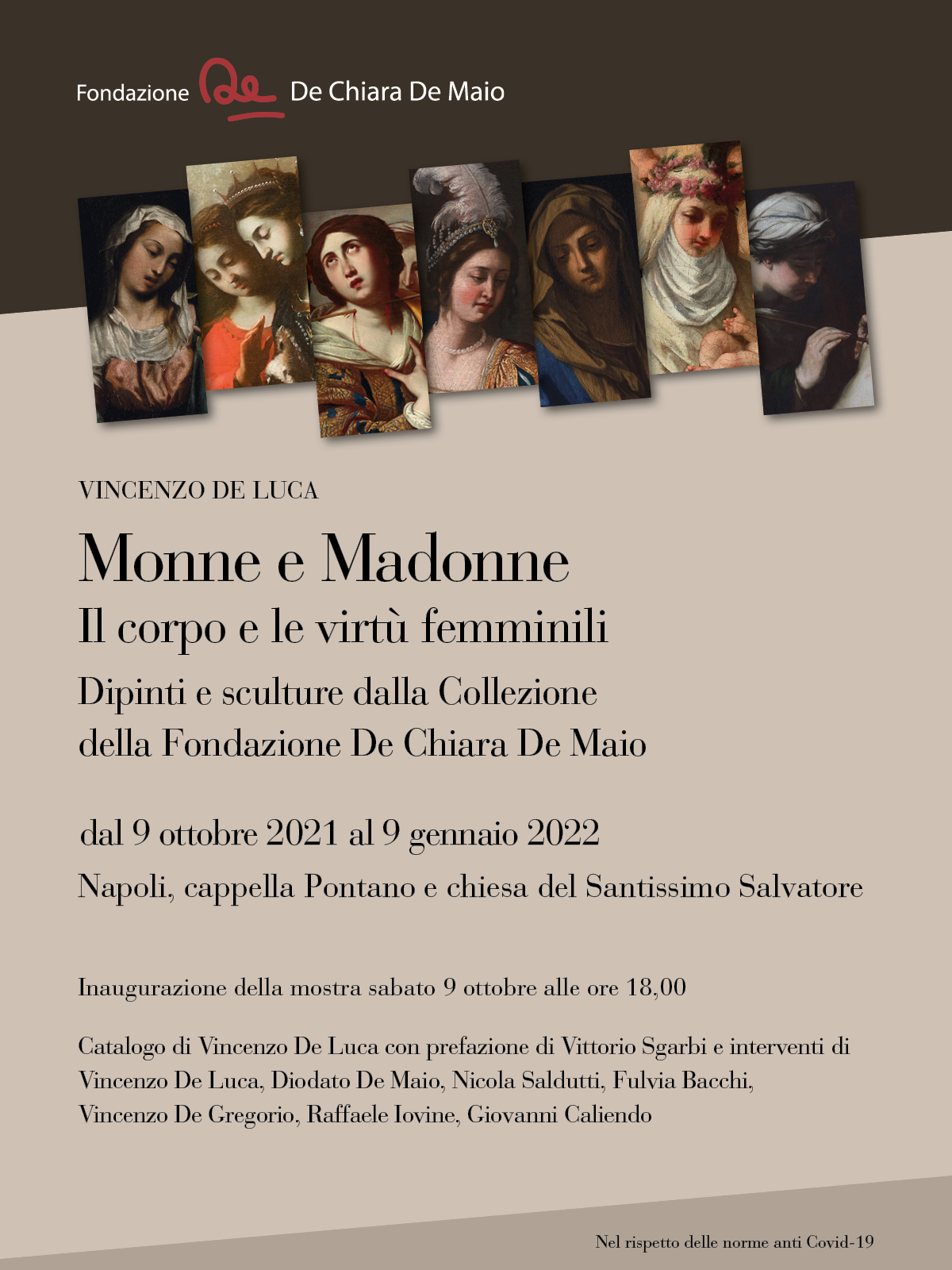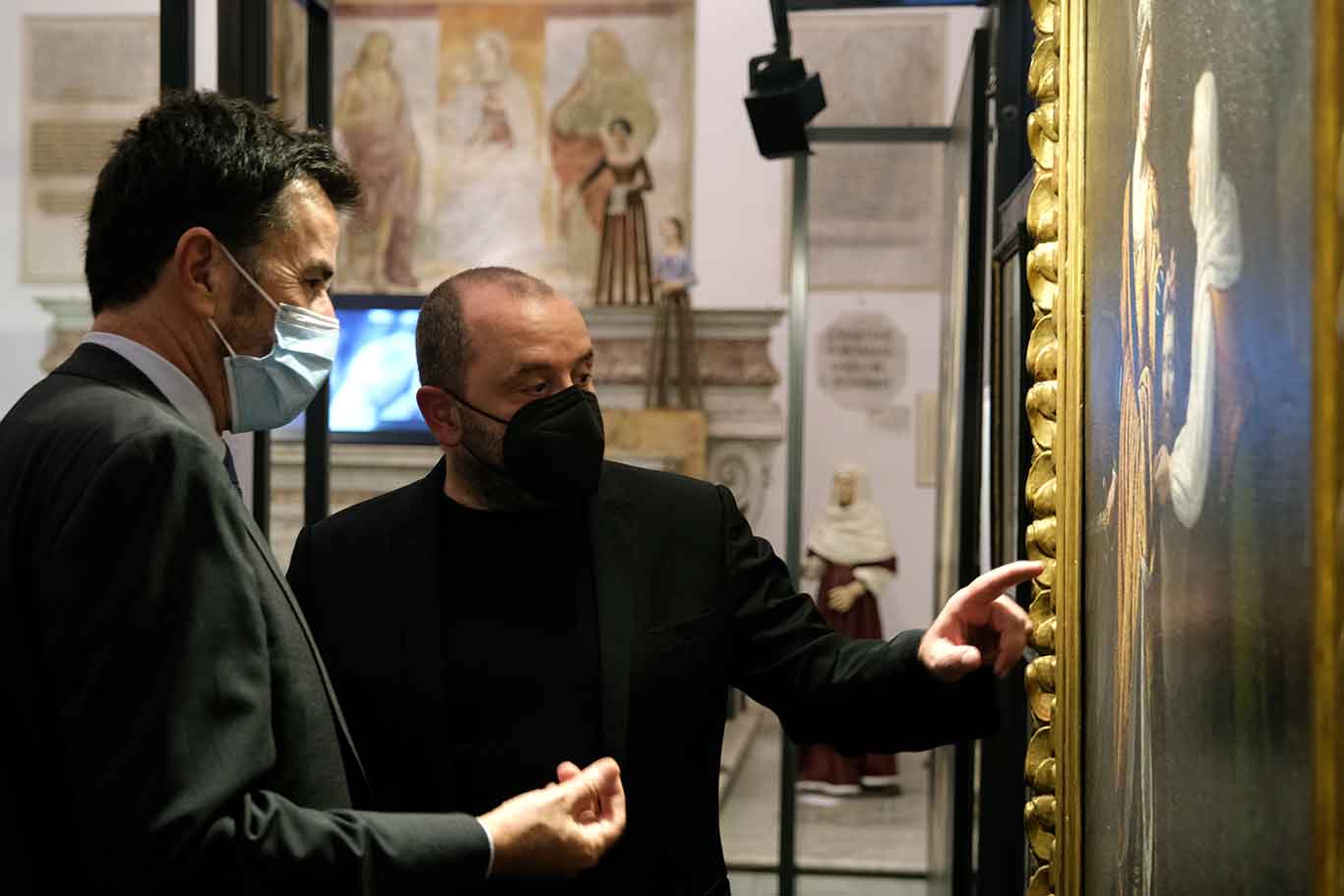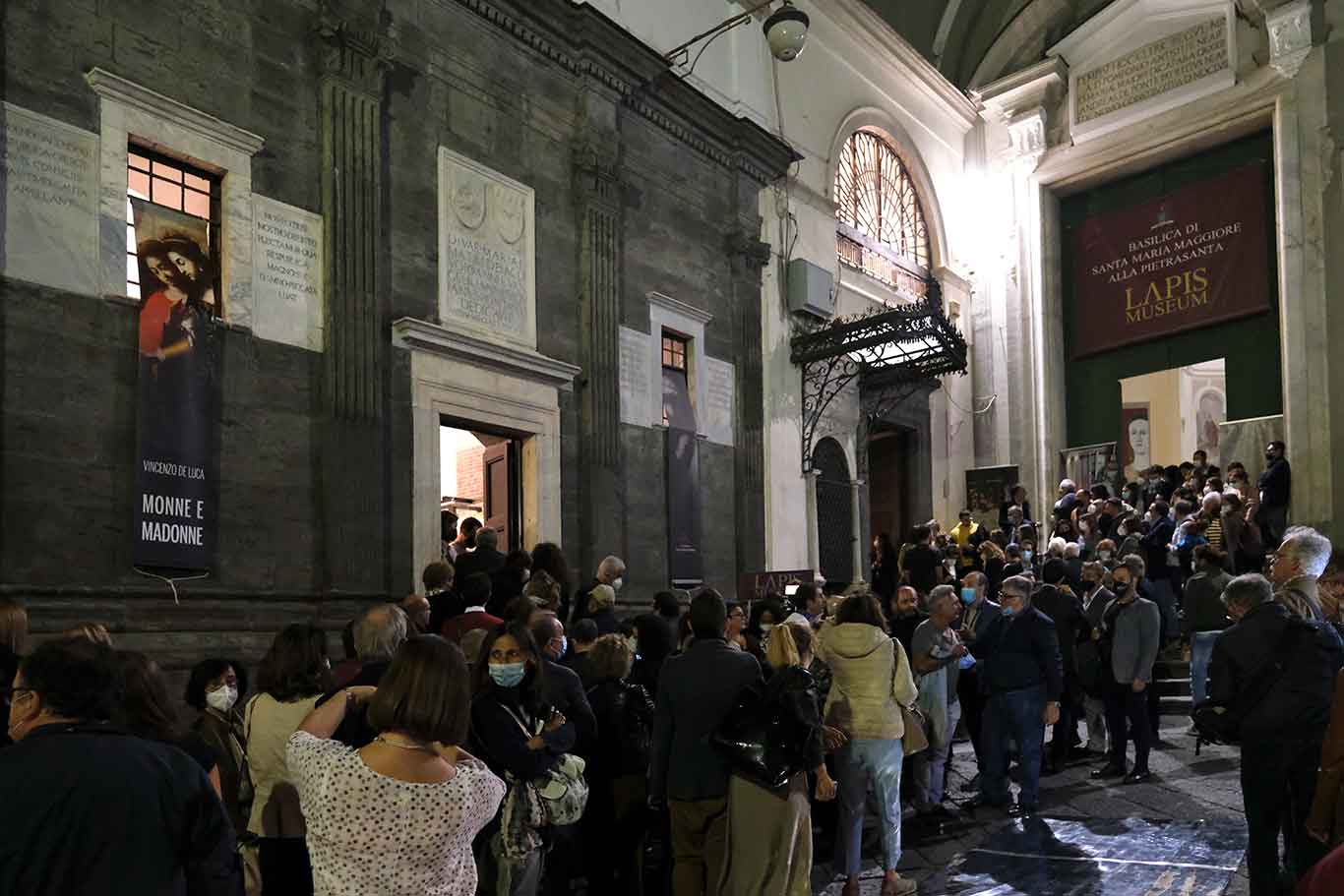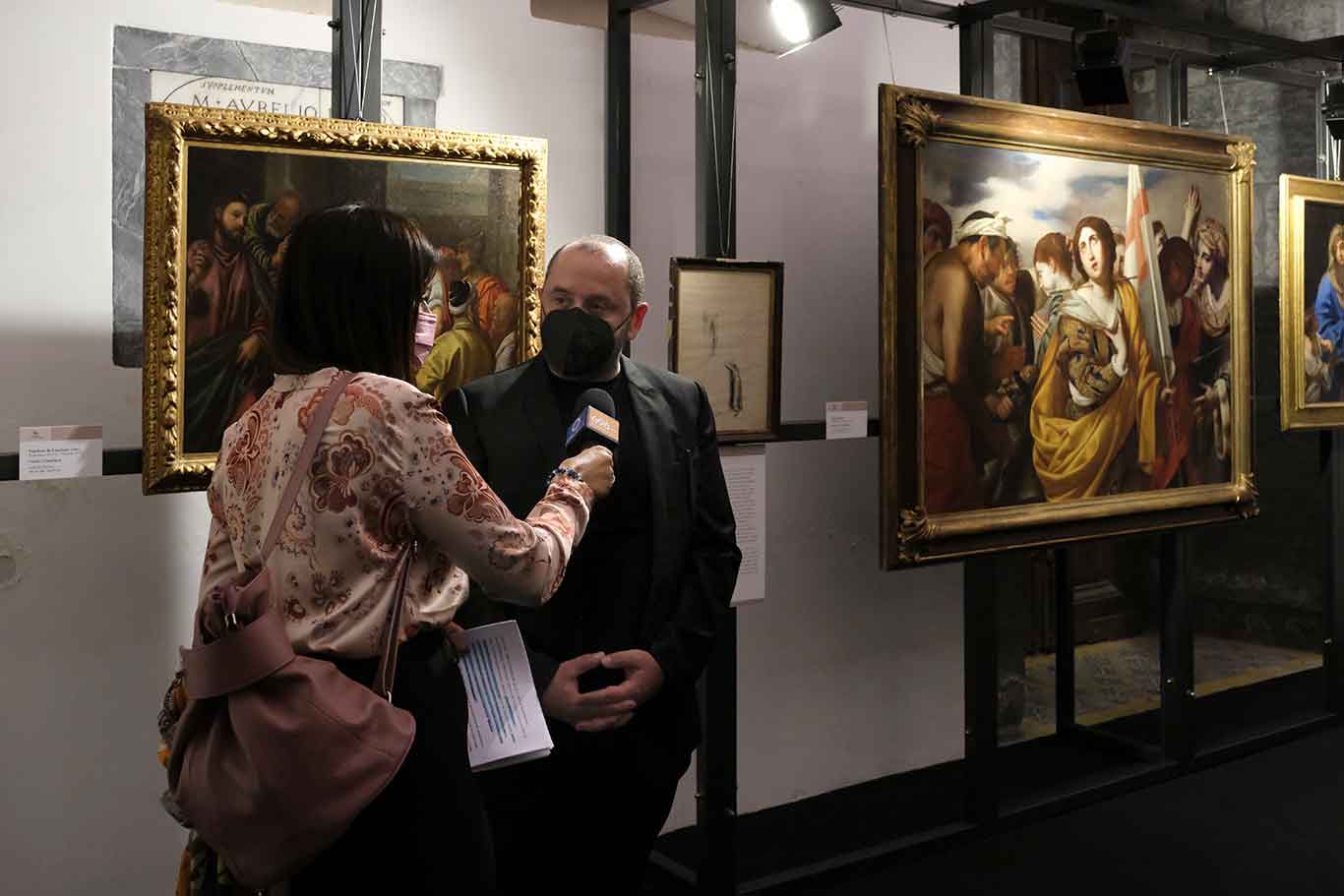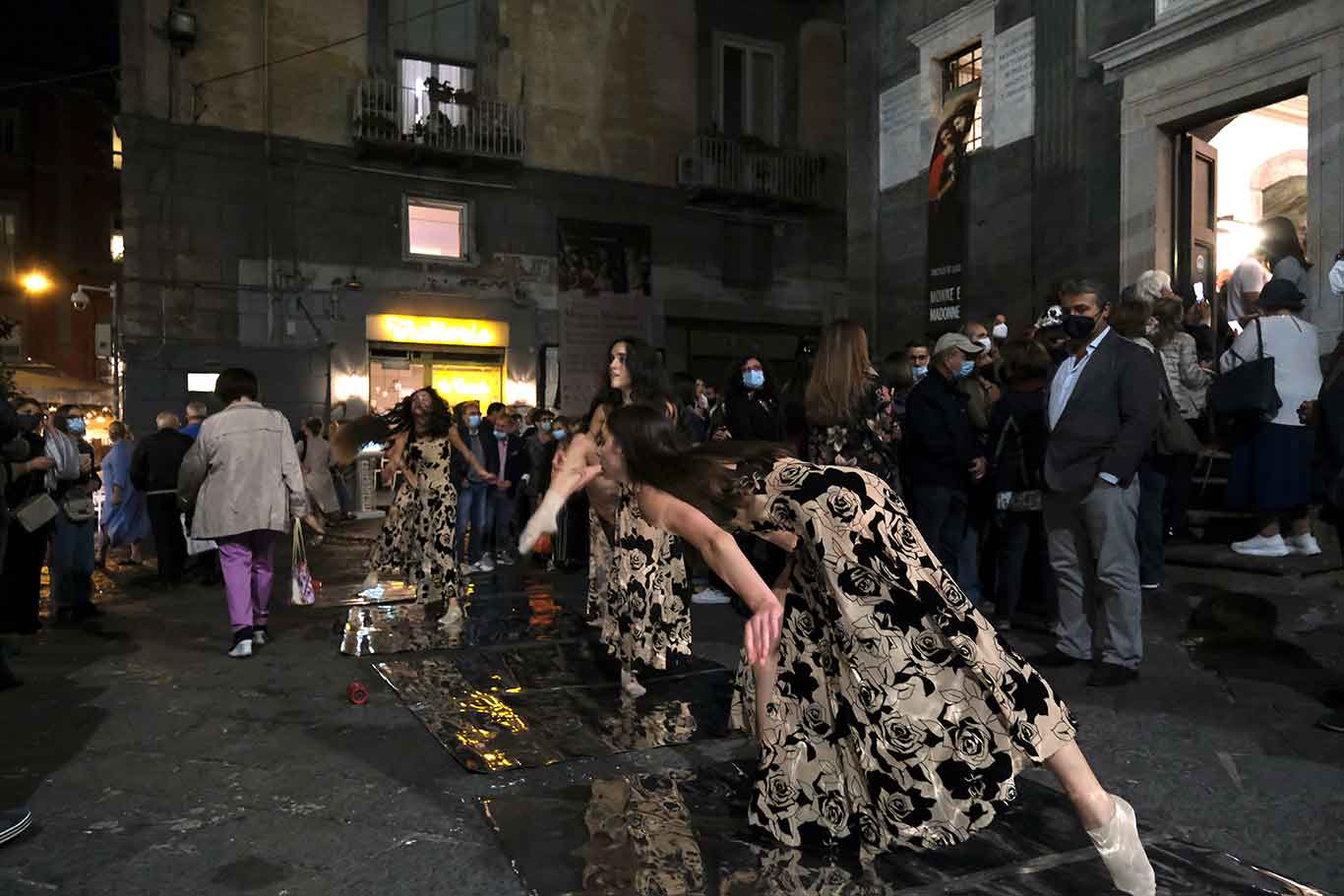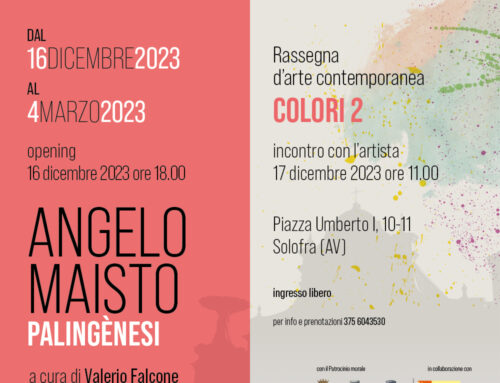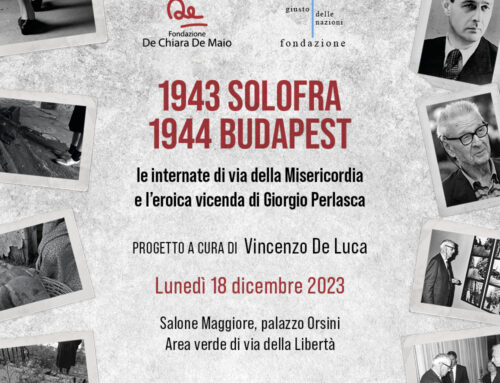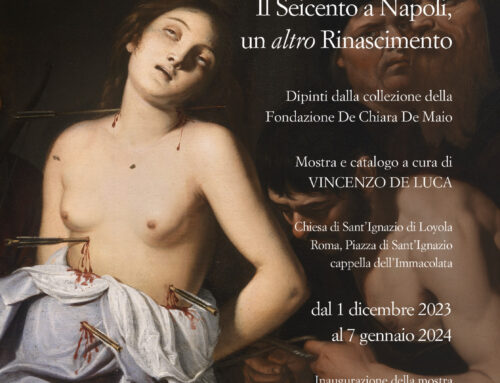Monne e Madonne
Il corpo e le virtù femminili
dipinti e sculture dalla collezione della Fondazione De Chiara De Maio
Cappella Pontano e la chiesa del Santissimo Salvatore – Via dei Tribunali, Napoli
Dal 09 ottobre al 09 gennaio 2022 – Orari: 10.00 – 20.00 – Tutti i giorni della settimana.
Listino prezzi
Abstract Monne e Madonne
Comunicato Monne e Madonne
Scarica la locandina
Proposta didattica
+39 375 604 3530
Chatta con noi
info@fondazionede.it
Stazione metro consigliata:
Linea 1 Metropolitana – Stazione Dante
Monne e Madonne
Il corpo e le virtù femminili
dipinti e sculture dalla collezione della Fondazione De Chiara De Maio
Napoli, cappella Pontano e chiesa del Santissimo Salvatore in via Tribunali
Cappella Pontano e la chiesa del Santissimo Salvatore
Via dei Tribunali, Napoli
Dal 09 ottobre al 09 gennaio 2022
Orari: 10.00 – 20.00
Tutti i giorni della settimana.
Listino prezzi
Abstract Monne e Madonne
Comunicato Monne e Madonne
Scarica la locandina
Proposta didattica
+39 375 604 3530
Chatta con noi
info@fondazionede.it
Stazione metro consigliata:
Linea 1 Metropolitana – Stazione Dante
ABSTRACT DELLA MOSTRA
Le ragioni di una mostra sulla donna nella cappella Pontano e nella chiesa del Santissimo Salvatore in via Tribunali
di Vincenzo De Luca
professore di Storia dell’Arte
La quotidianità di Pontano si spendeva tutta in quella zona, abitando a poca distanza in un palazzo di fronte alla torre campanaria della chiesa di Santa Maria Maggiore alla Pietrasanta. Buona parte della sua produzione letteraria è una dedica alla bellezza, anche alla donna come generatrice d’amore. In alcuni versi dal De amore coniugali così si rivolge alla propria donna (traduzione dal latino di Adriano Gimorri, 1920):
E tu, mia moglie adorata, la luce imitar non vorrai? Dunque con me vivrai sempre così ostinata? Breve è la vita, o sposa, più breve è beltà di fanciulla: è come un lieve nulla il tuo color di rosa. Ahi, qual ci resta fortuna? La triste vecchiaia sen viene: reca le lunghe pene, reca la morte bruna. Questi tuoi anni trascorsi invano rammenterai sola godi (l’istante vola!) se non vorrai rimorsi. Questo ti dice la forma tua bella e l’ardor del marito, questo d’Imene il rito, questo d’amor la norma.
La cappella Pontano è il luogo ideale per l’allestimento della mostra Monne e Madonne. Il corpo e le virtù femminili, per lo più dipinti legati dalla tematica, centrale o defilata, esplicita o appena suggerita, della donna, principalmente del Seicento (a eccezione di una tavola e una tela della metà del Cinquecento e di pochi altri tra Settecento e Novecento).
I termini ‘monna’ e ‘madonna’ sono strettamente legati. Madonna è un titolo d’onore che si usava dal Medioevo in poi parlando di una donna tra le classi più abbienti e che in tempi più recenti ha come riferimento unico la Vergine Maria. L’etimologia è infatti ‘mia donna’. E monna ne è la contrazione. Monna e madonna quasi si confondono e diventano nella mostra il desiderio di recuperare lo sforzo dei pittori di esaltare della donna l’armonia fisica o la forza dei sentimenti.
Non c’è luogo più indicato dove la donna può essere raccontata a Napoli, perché proprio in quest’area di via Tribunali, dove insiste anche la cappella Pontano, sorgeva in epoca pagana il tempio dedicato al culto di Diana, protettrice della caccia, degli animali selvatici, delle donne e della loro verginità spesso scelta per evitare matrimoni indesiderati. Queste sacerdotesse erano le dianare, ancora oggi ricordate a Napoli come janare, bollate come streghe, viste poi, nel periodo paleocristiano, come affiliate al demonio. Così si spiegherebbe la genesi della costruzione, nel Medioevo, della chiesa di Santa Maria Maggiore della Pietrasanta dedicata alla Vergine per combattere il demonio che in questa zona si materializzava sotto forma di maiale.
Le opere della mostra, divise in due blocchi, ovviamente ognuno in numero di otto per entrare in sinergia mistica con i simboli della costruzione, raccontano – l’uno – la bellezza del corpo e – l’altro – i valori dei sentimenti e del comportamento femminile.
Perché se nella cappella Pontano la dedica è alle fattezze anatomiche della donna, nell’attigua chiesa del Santissimo Salvatore sono evocate le virtù. Questa piccola chiesa, per dimensione simile alla vicina cappella, può considerarsi, anche per un passato storico comune, un suo prolungamento.
Entrando, la tela d’altare racconta la Trasfigurazione, probabilmente opera di Giuseppe Marullo ma a leggere la fonte di Aspreno Galante (Guida Sacra della città di Napoli, 1872) è da attribuire ad Annella de Rosa: tra la Pontaniana e S. Maria Maggiore è il tempietto del Salvatore colla Congrega del Sacramento, formato da qualche residuo dell’antica Pomponiana, ma interamente restaurato nel 1766. Vi si osserva una tela della Trasfigurazione di Annella de Rosa discepola di Massimo; e nel muro a sinistra un trittico, col Calvario nel mezzo, ed ai lati Carlo Magno col titolo di Santo, e S. Luigi di Francia, credesi del Criscuolo.
L’opera più interessante è proprio quella sulla parete di sinistra; Giovanni Filippo Criscuolo, nativo di Gaeta e formatosi tra le botteghe di Andrea da Salerno e Perino del Vaga, può definirsi un divulgatore, verso la metà del Cinquecento, del raffaellismo a Napoli.
I due riferimenti di Annella de Rosa e Giovanni Filippo Criscuolo quasi impongono di farli dialogare con due opere specifiche della mostra, il Martirio di Sant’Orsola ascrivibile a Filippo Vitale in collaborazione con Pacecco de Rosa e il San Michele Arcangelo di Marco Pino da Siena. Il primo riferimento, pure nella errata attribuzione della Trasfigurazione ad Annella, vale quale ricongiungimento tra fratello e sorella, Pacecco e Annella, e idealmente quale richiamo al fervore artistico in zona Monteoliveto poco prima della metà del Seicento, come si legge nelle fonti settecentesche di Bernardo De Dominici, le Vite de’ pittori, scultori ed architetti napoletani. Per il secondo riferimento va considerato che con Marco Pino, in una Napoli addolcita dalle maniere di Raffaello (in una cappella nella chiesa di San Domenico Maggiore c’era la sua Madonna del pesce, oggi al Prado di Madrid, che Criscuolo replicherà nelle figure centrali della Madonna con il bambino in un suo polittico di Novi Velia), arrivò anche la rivoluzione michelangiolesca (corpi decisamente muscolosi, movimenti serpentinati e nervosi, impostazione d’assieme chiaramente drammatica).
A fare da raccordo tra la forza del corpo e le virtù del comportamento nei due ambienti fanno da vestali alcune statue lignee del Seicento e del Settecento, Madonne ormai svestite da tempo e dal tempo, senza più abiti di seta e gioielli, in bilico tra oggetto scultoreo, inserti di arte minore (gli occhi di vetro) e pittura. Probabilmente tutte di bottega napoletana, arredavano case signorili, tra la devozione sacra e la passione per l’oggetto ricercato. Il manichino snodabile, per esigenze artistiche, era già presente da secoli nelle botteghe degli artisti. Giorgio Vasari, nella Vita di Fra’ Bartolomeo, pittore fiorentino, scrive che aveva openione fra’ Bartolomeo quando lavorava tenere le cose vive innanzi, e per poter ritrar panni et arme et altre simil cose fece fare un modello di legno grande quanto il vivo che si snodava nelle congenture, e quello vestiva con panni naturali dove egli fece di bellissime cose, potendo egli a beneplacito suo tenerle ferme fino che egli avesse condotto l’opera sua a perfezione. E il manichino arriva, nella
finzione pittorica, ad alimentare nel Novecento le tele metafisiche di Giorgio de Chirico.
Una delle statue lignee si presta a un progetto di recupero ideale della propria storia, quando era ancora vestita. Maria Rosaria Santin propone, in collaborazione con alcuni allievi del Liceo Artistico Caravaggio di San Gennaro Vesuviano, la vestizione del manichino con l’utilizzo quasi esclusivo di pelli per l’abito e il copricapo.
La mostra include anche un progetto sinestetico, una sorta di contaminazione sensoriale, rendere visibile con il tatto un dipinto ai non vedenti. Ma non solo, anche per chiunque voglia leggere l’immagine in modo diverso, gustandone con le mani sporgenze e rientranze. L’opera presa in esame è il Mosè salvato dalle acque di Antiveduto Gramatica, che diventa dapprima una scultura in argilla, di grandezza pari al dipinto, realizzata da Antonio Teodorico Avello sempre con alcuni allievi del Liceo Artistico Caravaggio di San Gennaro Vesuviano. Le sporgenze di paesaggio e figure vanno dallo stiacciato al basso e all’altorilievo fino quasi al tutto tondo. La Fonderia Nolana Del Giudice ha poi tradotto il lavoro di Avello in un unico blocco di alluminio.
Per l’allestimento della mostra, la sospensione delle opere su uno scheletro architettonico essenziale a poca distanza dalle pareti consente di vedere oltre, senza invadere l’armonia originale dei due ambienti. Per detta premessa di rispetto dei luoghi, non volendo evidenziare determinati dettagli dei dipinti con luci dirette ma la convivenza pro tempore di due pari livello, cioè il contenuto dei quadri nel doppio contenitore della cappella e della chiesa, è stata decisa un’illuminazione diffusa con pannelli led da studio fotografico e cinematografico. Verso i due altari, il richiamo al cinema è garantito in due postazioni video che riproducono due documentari su due opere cardine della mostra, la narrazione del San Sebastiano e le pie donne di Luca Giordano (interpretato da Francesco Paolantoni) nella cappella Pontano e il Mosè salvato dalle acque (interpretato da Gigi Savoia) nella chiesa del Santissimo Salvatore.
Così come i due ambienti interagiscono con i quadri ospitati, gli stessi dipinti dialogano con le proprie cornici, anch’esse spesso vere opere d’arte. È emiliana della fine del Cinquecento la cornice del San Michele Arcangelo di Marco Pino da Siena e, sempre dello stesso periodo, se non leggermente più antica, quella senese del disegno di Fernando Botero della Monna Lisa, in pastiglia con finiture d’oro. Della prima metà del Seicento sono la cornice piemontese del dipinto di Polidoro da Lanciano, la cassetta emiliana dell’anonimo pittore prossimo al Sassoferrato, quella dell’area centrale della penisola della Sant’Agata di Francesco Guarini e la Salvator Rosa dorata a mecca sempre dell’area tra Roma e Napoli dell’anonimo pittore dell’Annunciazione.
ABSTRACT (english version)
In the entanglement of architectural experiences in Via Tribunali (the “decumano maggiore” of the ancient centre of Naples), where the stratifications start from the Greek period as far as the Baroque, the most “linear” manifestation reveals itself with the Pontano’s chapel. It’s a noble example of a Renaissance building, made in 1492 – when Columbus reached the New World and when Lorenzo il Magnifico, pillar of the Medici family, died. The Pontano Chapel, just like other neapolitan buildings and other documents of its commissioner Giovanni Gioviano Pontano, proves that the Renaissance was also in the south of Italy.
Like every other pagan temple of the Christian era, the chapel stands between rationality and faith; and indeed, it’s geometry evokes the symbolic coexistence between finite and infinite. The layout of the chapel is rectangular and the elevation makes a parallelepiped: straight lines that allude to the sensual experience and the mundane world. The barrel vault suggests, on the contrary, realities outside of this world.
In the same years of the construction of the chapel, Leonardo da Vinci, with its Vitruvian Man, condemns the anatomical perfection of the men inscribed in a cube that represents the Earth and a circle that symbolizes the Sky. Pontano commissioned the chapel the honor the memory of his wife Adriana Sassone, who died in 1490. The idea of an antiquarium is given by the many marbled tombstones with Greek and latin transcriptions, written by Pontano himself, that celebrate civil virtues and private sorrow.
Another symbol of the chapel is the octagon, with broken lines that aim at the perfection of the circle, implying how an uncertain human life is illuminated by the divine. The number eight of the octagon, the man that searches the infinite, can be found in recurring details of the chapel, like the majolica tiles of the pavement made out of octagons framed in each other. And actually, the number eight returns thanks to time itself, because at eight o’ clock in the morning, during the summer solstice, the sun entered the rose window of the chapel and hit the place where once was the octagonal tombstone of Pontano’s wife.
The number eight is the symbol of Mary and it is no coincidence that on the altar of the Pontano Chapel we have a late fifteenth-century fresco of the Madonna con Bambino e i Santi Giovanni Battista ed Evangelista. The number eight is also the symbol of resurrection, the “dies octavus” for Christians, an omen for a peaceful eternal sleep for Pontano’s wife and children. Pontano’s everyday life was always in that area, because he lived in a building close by. Most of his literary production is dedicated to beauty, to the image of the woman as the mother of love.
The Pontano chapel is the ideal place for the exhibition Monne e Madonne. Il corpo e le virtù femminili, with paintings that are connected to, in a central or concealed way, the image of the woman, primarily in the 17th century (expect for a painting of the first half of the 16th century and few others of the 18th and 20th century). The terms “monna” and “Madonna” are strictly connected. Madonna is a title of honor used since the Middle Ages meaning a woman of high class and then, in modern times, solely as the Virgin Mary. The etymology is, in fact “mia donna” (my woman). And “monna” is a contraction of this term. Monna and Madonna are blurred between themselves and they become, in this exhibition, the desire to regain the effort of the painters in glorifying the natural harmony or the power of the feelings of the women.
And the best place to portray the woman is Naples, precisely because here in via Tribunali, there was in pagan times a temple dedicated to the worshipping of the goddess Diana, goddess of the hunt, of wild animals, of the women and their virginity. These priestesses were the “dianare”, now known as the “janare”, marked as witches and then seen as connected to the devil. And so would be clear the origin of the construction, in the Middle Ages, of the churc of Santa Maria Maggiore della Pietrasanta dedicated to the Virgin in order to fight the devil that, in this area, manifested in the form of a swine.
The paintings, divided in two sections – each one made out, of course, of eight paintings – narrate on one side the beauty of the body, and on the other the values of female feelings and attitudes. And that’s because if the Pontano’s chapel is dedicated to the anatomic features of the woman, the nearby church of the Santissimo Salvatore evokes the virtues. This little church, similar to the other chapel, can be seen as its extension. When entering the church, the painting of the alter tells the story of the Transfiguration, maybe painted by Giuseppe Marullo or, according to Aspreno Galante, made by Annella de Rosa. And the most interesting painting is on the left wall, the work of Giovanni Filippo Criscuolo, born in Gaeta and trained in the workshops of Andrea da Salerno and Perino del Vaga. He can be considered a spreader of the “raffaellismo” in Naples.
The two references to Annella de Rosa and Giovanni Filippo Criscuolo necessarily have to communicate with two specific paintings of the exhibition, that is to say the Martirio di Sant’Orsola, made by Filippo Vitale and Pacecco de Rosa, and the San Michele Arcangelo, made by Marco Pino da Siena. The first mention, even if the attribution of the Transfiguration to Annella is wrong, creates a reunion between brother and sister, Pacecco and Annella, and ideally to evoke the artistic enthusiasm born in the area of Monteoliveto just before the first half of the 17th century (just as is said by the sources of Bernando De Dominici in Vite de’ pittori). For the second mention we need to consider that with Marco Pino, in a Naples softened by Raffaello’s style, comes a revolution that has its origin in Michelangelo (the bodies become muscular, the movements more tense, and the setting is far more dramatic). As a form of junction between the power of the body and the virtues of the attitude there are some statues made out of wood made between the 17th and 18th century, Madonnas now disrobed by time, without silk dresses and jewels, balanced between sculptural object, insets of minor arts (like the glass eyes), and painting. They were all probably made in Neapolitan workshops, and they decorated refined houses, between sacred devotion and a passion for sophisticated objects.
The articulated mannequin was for centuries already present in the artist’s workshops, as is the case of a mention made by Giorgio Vasari. And the mannequin arrives, in the artistic fiction, to feed the metaphysical works of Giorgio de Chirico.
Of the wood sculptures lend itself to an ideal work of retrieval of its own history, when it was still a clothed sculpture. Maria Rosaria Santin serves, in collaboration with some students of the Caravaggio High School in San Gennaro Vesuviano, the robing of the mannequin using almost exclusively leather for the dress and the headpiece. The exhibition includes also a synesthetic project, a sort of sensory contamination, that makes visible with touch one of the paintings for visually impaired people. Not just for them, but for anyone who wants to read the image in a different way, savoring its protrusions and nooks with their hands. The chosen paintings is Mosé salvato dalle acque made by Antiveduto Gramatica, that firstly becomes a clay sculpture, almost of the same size of the painting, made by Antonio Teodorico Avello with the collaboration of some apprentices of the Caravaggio High School in San Gennario Vesuviano. The indents of the landscape and the figures goes from flattened reliefs to the high-relief to almost the “all round”. The Del Giudice Foundry in Nola has then transposed the work of Avello in a single slab of aluminum. For the setup of the exhibition the suspension of the paintings on a basic architectural structure makes possible to see what’s behind the paintings, without invading the original harmony of the two rooms. In the same mindset, to respect the two spaces, were chosen soft lights like the ones in photo studio and cinematographic setups. And near the two altars there are two video setups that reproduce two documentaries about two of the paintings in the exhibition, San Sebastiano e le pie donne made by Luca Giordano (performed by Francesco Paolantoni) in the Pontano’s chapel and Mosé salvato dalle acque (performed by Gigi Savoia) in the Santissimo Salvatore church. The paintings interact not only with the two rooms themselves, but also with the frames that host them. It’s made in Emilia at the end of the 16th century the frame of San Michele Arcangelo made by Marco Pino da Siena and, of nearly the same period, it comes from Siena the frame that hosts the study of the Monna Lisa made by Fernando Botero, made with a “pastiglia” technique with 39 gold trims. Furthermore, the frames that can be dated back to the 17th century are the one from Piemonte in the painting made by Polidoro da Lanciano, the frame from Emilia of the Madonna con bambino, the frame from the central area of the Sant’Agata peninsula made by Francesco Guarini and the gold plated one made by Salvator Rosa that comes from the area between Rome and Naples used for the anonymous painter of the Annunciazione.
